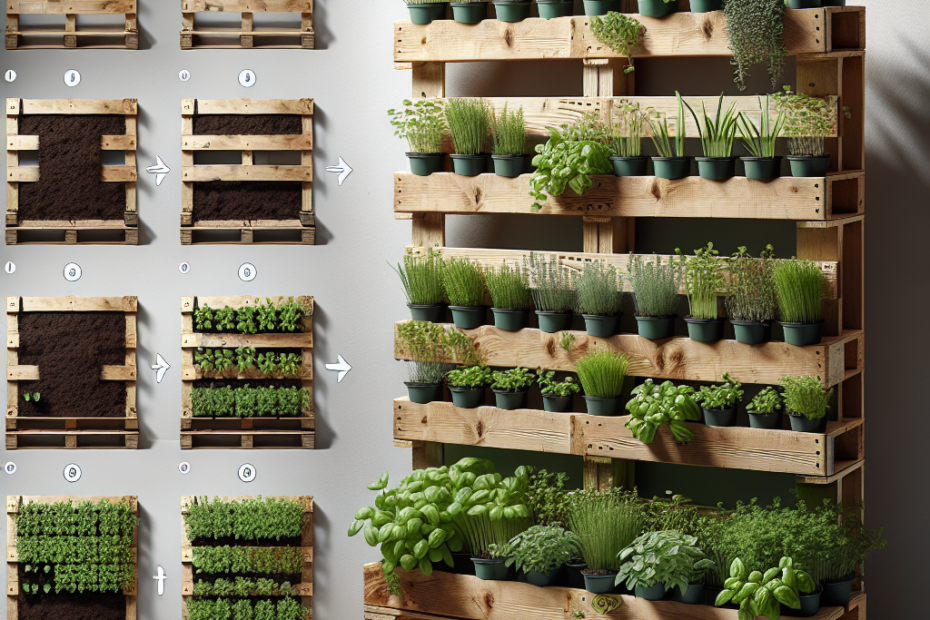“`html
Transforming a DIY Pallet Herb Garden: Step-by-Step Guide
In recent years, many people have been seeking creative and sustainable ways to enhance their garden spaces. Among these methods, transforming wooden pallets into vertical herb gardens has risen in popularity. It’s not just due to its aesthetic appeal but also because it maximizes limited space, making it ideal for urban dwellers. In fact, according to a 2022 survey by the National Gardening Association, over 35% of gardeners have shown interest in creating vertical gardens. This reflects a growing trend towards sustainable and space-efficient gardening.
Materials Needed for a DIY Pallet Herb Garden
- Wooden pallet (ensure it’s heat-treated and safe for gardening)
- Landscape fabric
- Staple gun and staples
- Potting soil
- Herbs of choice (like basil, mint, parsley, and thyme)
- Sandpaper
- Wood sealant (optional)
- Trowel
Steps to Create a Vertical Herb Garden from a Wooden Pallet
Turning a wooden pallet into a DIY pallet herb garden is a straight-forward process that anyone can achieve with a few tools and a little patience. Here’s a step-by-step guide:
1. Selection and Preparation of the Pallet
First, they need to choose a pallet that is safe for gardening. Look for a stamp indicating that it is heat-treated rather than chemically treated. This ensures that no harmful chemicals will leach into the plants. They should sand down the pallet to remove any rough spots or splinters. Optionally, applying a wood sealant can increase the durability of the pallet, especially if it will be placed outdoors.
2. Creating the Base
The bottom and back of the pallet should be lined with landscape fabric. Using a staple gun, secure the fabric tightly to hold the soil in place once filled. This step essentially forms the base and prevents soil from spilling out while allowing water drainage.
3. Adding Soil
Lay the pallet flat on the ground and begin filling it with potting soil. They should fill each slot evenly so that plants have adequate space to root. It’s essential that the soil they use is rich in organic matter to provide nutrients for the herbs.
4. Planting the Herbs
Now comes the exciting part—planting the herbs! They should start by deciding which herbs they enjoy the most and which ones thrive in similar conditions. Popular choices like basil, mint, and parsley often do well. Using a trowel, create small holes in the soil and gently place each plant into its new home, covering the roots with soil.
5. Setting Up the Vertical Garden
Once everything is planted, they need to carefully lift and set the pallet vertically in the desired location. This spot should ideally receive ample sunlight based on the herbs chosen. If outdoors, it’s a good idea to secure the pallet to a wall or sturdy structure to prevent tipping over during windy conditions.
Maintenance Tips for a Thriving Herb Garden
Their DIY pallet herb garden requires regular care to thrive:
- Regular watering, especially during dry spells, ensures herbs remain healthy. However, avoid over-watering as it can lead to root rot.
- Pruning the herbs regularly not only promotes growth but also prevents them from becoming too leggy.
- Checking for pests is vital. They can use organic pesticides or introduce beneficial insects to manage pests naturally.
- Seasonal rotation of herbs can help manage soil health, ensuring that they have a productive garden year-round.
Key Takeaways
- Wooden pallets provide an affordable and eco-friendly option for creating vertical herb gardens.
- Proper preparation ensures safety and durability.
- Consistent care and maintenance lead to a thriving herb garden.
- This DIY project is a perfect choice for small spaces and urban living.
| Materials Needed | Tools Required | Herbs Suggestions |
|---|---|---|
| Wooden pallet, Landscape fabric, Potting soil, Herbs | Staple gun, Sandpaper, Trowel | Basil, Mint, Parsley, Thyme |
Frequently Asked Questions
1. Can any wooden pallet be used for a herb garden?
No, they should use pallets that are heat-treated, indicated by an “HT” stamp, to avoid harmful chemicals.
2. How do they ensure the garden lasts through different seasons?
Applying a wood sealant can protect the pallet from weather damage, and rotating herbs seasonally helps maintain soil health.
3. What herbs are best for sunny spots?
Herbs like basil, rosemary, and thyme thrive in sunny locations, requiring good sunlight exposure for growth.
4. How often should they water the herbs?
Watering needs depend on the season and climate, but generally, they should water when the top inch of soil feels dry.
5. Do they need any special soil for growing herbs?
Using good-quality potting soil rich in organic matter will help provide essential nutrients for the herb garden.
Creating a DIY pallet herb garden is a rewarding project that offers both functional and aesthetic benefits. With careful planning and regular maintenance, they can enjoy fresh herbs virtually at their fingertips.
“`
